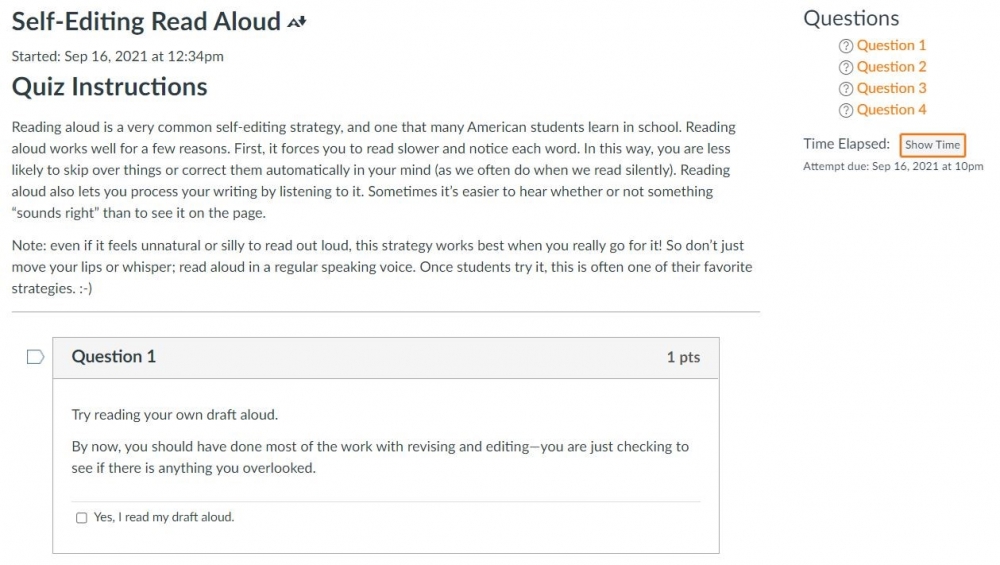6 Self-Editing Strategies for L2 Writers
by Amy Cook

As writing teachers, we support our students through all
stages of the writing process. This article provides concrete strategies for
self-editing developed in my writing classes for English for speakers of other
languages (ESOL) undergraduate and graduate students at a public university. In
these classes, I make a distinction between revision, which addresses larger
scale changes (such as ideas and organization), and editing, which focuses on
grammar and mechanics. With these self-editing exercises, my goal is to
introduce students to strategies for finding and correcting mistakes in their
own writing.
Why We Should Teach Language Learners
Self-Editing Skills
There are several reasons I make time to focus on
self-editing with second language (L2) writers.
-
They ask for it: My
students often request structured guidance and support in self-editing—it’s a
skill they’d like to improve.
-
They need it: It’s
also a skill I believe my students need, particularly outside of ESOL classes,
where they are not likely to have the same level of support that I can provide
with sentence-level issues.
-
It gives them
confidence: Practicing the strategies in my classroom can give
students confidence to continue using the strategies in the future.
Thus, I’ve developed a series of self-editing
strategy guides for my L2 writing classes. My ultimate goal is to empower these
L2 writers by improving their independent writing and editing skills through practice
and reflection. The process pushes students to try some new strategies, knowing
some will work better than others for different individuals. In the end,
students should leave my class with a handful of strategies they can continue
to use.
It’s important, though, to acknowledge that
self-editing doesn’t necessarily lead to error-free writing, and that the
overall class focus is still on effective communication, while taking steps
toward greater accuracy (Ferris 2008).
The Method
I introduce self-editing by providing an overview
to students (Appendix A), outlining my aforementioned rationale. Then, I
present one self-editing strategy with each writing assignment throughout the
semester. For each strategy, I explain how and why it works, then students
practice with step-by-step instructions to guide them in applying the strategy
to their own writing.
Finally, students reflect on the strategy,
considering what kinds of changes they made and whether they would use the
strategy again in the future. Originally, I provided paper-based guides for my
students, but, more recently, I have adapted the format by creating graded
surveys in our LMS, Canvas. The most important consideration is that students
have clear, concrete instructions to follow as they work with their own
writing.
The Strategies
Here are short descriptions of the strategies I
most commonly present to students. In a given semester, I typically choose one
strategy for each writing project, depending on the course, student level,
specific assignments, etc. You can find the full guide with steps for students
in Appendix B. Please feel free to use or adapt with attribution.
1. Read
Aloud
For this simple strategy, students are asked to
read their draft out loud (see the Figure; instructions partially adapted from
Ferris, 2014). This helps to slow them down and hear mistakes they may not
notice when reading silently. Although this strategy is widely known among
writing teachers, I have students each semester who have never tried it before!
Tip: students who struggle with oral
fluency may benefit from using a text-to-speech program and listening rather
than reading aloud themselves.

Figure. Screenshot of Canvas graded survey for read
aloud strategy. (Click here to enlarge)
2. Reading
Strategies
After asking students to read aloud, I present
three additional reading strategies that help students slow down and/or see the
writing with a new perspective:
Printed Copy
Students print a paper copy of the draft to see
what they notice on a printed page that they didn’t see on the screen. (How
many times have we, as teachers, noticed a mistake in our own course materials
only after printing the copies for the whole
class?)
Reading Backward
Students start with the last sentence of the draft,
and read it backward, sentence-by-sentence. This removes the writer from the
flow of ideas, so that sentence-level issues are easier to notice.
Reading Line-by-Line
Here, students can read on screen, by adjusting the
size of the word processor window, or on paper, by covering up a printed copy
with another piece of paper and revealing one line at a time.
3. Pattern of
Error
Here, students choose one area to focus on, looking
only for those types of mistakes (partially adapted from Ferris, 2014).
Sometimes students are already aware of grammar areas they typically struggle
with. These are some common areas I also recommend for students who aren’t sure
what to focus on:
- Verb form and/or verb tense
- Subject-verb agreement
- Noun endings (plural, possessive)
- Articles
- Punctuation and/or run-ons and/or
fragments
This kind of editing takes a lot of time, but it’s
very effective. It helps students notice more mistakes because they are
focusing their attention to look for them. It also helps students review the
rules for common trouble areas, and making repeated corrections should help
writers make fewer mistakes in the future.
If there are several areas writers want to check, I
suggest editing in multiple rounds—each time focusing on just one area.
4. Time
This is another simple strategy, but it requires a
bit of planning ahead. Students take a break of at least 30 minutes (or even
better, overnight), then proofread their draft. Taking a break and seeing the
document with “fresh eyes” helps students to notice things they wouldn’t have
otherwise.
5. Tech
Tools
There are many tools that can help writers improve,
but no tool is perfect! I suggest that students try out several tools, and take
note of what each tool can and can’t help with (instructions partially adapted
from Ferris, 2014). Most students already use the word processor spell and
grammar checkers, for example. Here are some other technology tools I recommend
to students:
Ludwig
(also an app)
This free site lets students type in a sentence or
phrase and see other examples of similar phrases. Students can compare their
writing to authentic samples to see if they might need to make corrections. See
instructions here.
Virtual
Writing Tutor
This is a free spell/grammar checker designed for
L2 writers. It has other features, too, like help with paraphrases and
vocabulary. There are explanations about all these features on the site, some
with explainer videos.
Speech recognition and
text-to-speech
- Speech recognition allows a device to type words
users say out loud. Some students find it easier to process ideas by talking
first, so they can use speech recognition to create a first draft by talking
instead of typing.
- Text-to-speech allows devices to read out loud to
users. This can help students use their listening skills to help with reading
as well as editing.
- Specific tools:
- Microsoft Office and Windows (instructions here
and here)
- Google Docs Voice Typing (instructions here)
- Apple Dictation for i0S (instructions here)
- Natural
Reader (free & paid versions)
With all of these tools, it’s important to remind
students to rely on their own knowledge and experience to help them make the
best decisions about their own writing. Each tool can be useful, but they are
not perfect. Ultimately, writers have to be responsible for their own work by
evaluating the advice from tech tools carefully. I also remind students that
there are no shortcuts to becoming a better writer—they must practice writing!
6. Your
Choice!
After trying several of the above, students pick
which one(s) to use. I often provide this option toward the end of the
semester, either on a final project or a reflective piece. It is always
interesting to see what students choose and why.
The
Takeaways
I imagine this list of self-editing strategies
includes some that you’re already familiar with, and I hope it also includes
some fresh ideas you’d like to try with your students. In my experience,
students appreciate the chance to try a variety of strategies, and they usually
encounter a few that they continue to use on their own. In a recent class,
nearly half of the students specifically mentioned self-editing in their final
projects, showing that it was a useful and memorable class activity.
Note: This article is based on the
presentation “Self-Editing Strategies for L2 Writers,” delivered at the TESOL
International Convention, March 2022, Pittsburgh, Pennsylvania, USA.
References
Ferris, D. R. (2008). Students must learn to
correct all their writing errors. In J. M. Reid (Ed.), Writing myths:
applying second language research to classroom teaching (pp.
90–114). University of Michigan Press.
Ferris, D. R. (2014). A guide to college
writing for multilingual/ESL students. Fountainhead Press.
Suggested
Resource
Ferris, D. R. (2011). Treatment of error in second language student writing (2nd
ed.). University of Michigan Press.
Amy
Cook is originally from Albuquerque, New
Mexico, where she completed a BA in languages and Latin American studies. She
also holds an MA in teaching English as a second language from the University
of Arizona. Amy is a teaching professor in the Department of English at Bowling
Green State University in northwest Ohio, USA. She enjoys working with a wide
variety of students in the ESOL, TESOL, and University Writing
Programs.